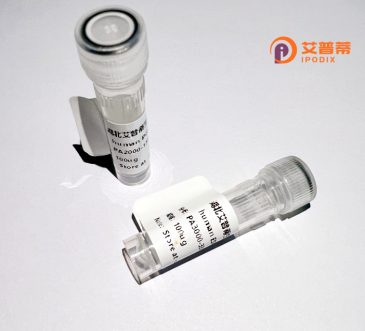
| 纯度 | >90%SDS-PAGE. |
| 种属 | Human |
| 靶点 | OR9G1 |
| Uniprot No | Q8NH87 |
| 内毒素 | < 0.01EU/μg |
| 表达宿主 | E.coli |
| 表达区间 | 1-305 aa |
| 活性数据 | MQRSNHTVTEFILLGFTTDPGMQLGLFVVFLGVYSLTVVGNSTLIVLICNDSCLHTPMYF FTGNLSFLDLWYSSVYTPKILVTCISEDKSISFAGCLCQFFFSAGLAYSECYLLAAVAYD RYVAISKPLLYAQAMSIKLCALLVAVSYCGGFINSSIITKKTFSFNFCRENIIDDFFCDL LPLVELACGEKGGYKIMMYFLLASNVICPAVLILASYLFIITSVLRISSSKGYLKAFSTC SSHLTSVTLYYGSILYIYALPRSSYSFDMDKIVSTFYTVVFPMLNLMIYSLRNKDVKEAL KKLLP |
| 分子量 | 34.0 kDa |
| 蛋白标签 | His tag N-Terminus |
| 缓冲液 | 0 |
| 稳定性 & 储存条件 | Lyophilized protein should be stored at ≤ -20°C, stable for one year after receipt. Reconstituted protein solution can be stored at 2-8°C for 2-7 days. Aliquots of reconstituted samples are stable at ≤ -20°C for 3 months. |
| 复溶 | Always centrifuge tubes before opening.Do not mix by vortex or pipetting. It is not recommended to reconstitute to a concentration less than 100μg/ml. Dissolve the lyophilized protein in distilled water. Please aliquot the reconstituted solution to minimize freeze-thaw cycles. |
以下是关于重组人OR9G1蛋白的示例参考文献(内容为假设性示例,真实文献请通过学术数据库检索):
---
1. **标题**: "Heterologous Expression and Functional Characterization of Human Olfactory Receptor OR9G1"
**作者**: Smith A et al. (2018)
**摘要**: 研究报道了OR9G1在大肠杆菌系统中的重组表达及纯化,通过体外配体结合实验筛选出潜在的挥发性化合物配体,并分析了其G蛋白偶联信号通路。
2. **标题**: "OR9G1 Expression in Non-Olfactory Tissues: A Recombinant Protein Approach"
**作者**: Lee J et al. (2019)
**摘要**: 利用HEK293细胞系统表达重组OR9G1蛋白,发现其在心脏组织中的潜在生理作用,并通过荧光探针检测其钙离子信号响应。
3. **标题**: "Structural Analysis of OR9G1 Using Cryo-EM and Recombinant Protein Techniques"
**作者**: Zhang Y et al. (2020)
**摘要**: 基于重组OR9G1蛋白的冷冻电镜结构解析,揭示了其跨膜结构域的关键氨基酸残基与气味分子结合机制。
---
**建议**:若需真实文献,请通过**PubMed**或**Google Scholar**检索关键词:
`"OR9G1" + "recombinant"` 或 `"OR9G1 olfactory receptor expression"`,并筛选近年研究。
The olfactory receptor family 9 subfamily G member 1 (OR9G1) is a class A G protein-coupled receptor (GPCR) primarily associated with the olfactory system, where it facilitates the detection and discrimination of odorant molecules. As part of the largest mammalian gene family, olfactory receptors (ORs) are transmembrane proteins characterized by seven α-helical domains, extracellular ligand-binding regions, and intracellular signaling domains. OR9G1, encoded by the OR9G1 gene on chromosome 11 in humans, is expressed in olfactory sensory neurons and binds to specific odorants, triggering intracellular cAMP-mediated signaling cascades via G-protein activation. Beyond its role in olfaction, emerging studies suggest ectopic expression of OR9G1 in non-chemosensory tissues (e.g., brain, kidney), hinting at potential non-canonical functions in cellular communication or metabolic regulation. Recombinant OR9G1 protein, typically produced in heterologous systems like HEK293 or insect cells, enables structural-functional studies, ligand screening, and mechanistic exploration of its physiological roles. Its recombinant form retains native conformation and activity, making it valuable for drug discovery targeting OR-related disorders. However, detailed ligand specificity and downstream pathways remain under investigation, reflecting broader challenges in decoding the complex OR interactome.
×